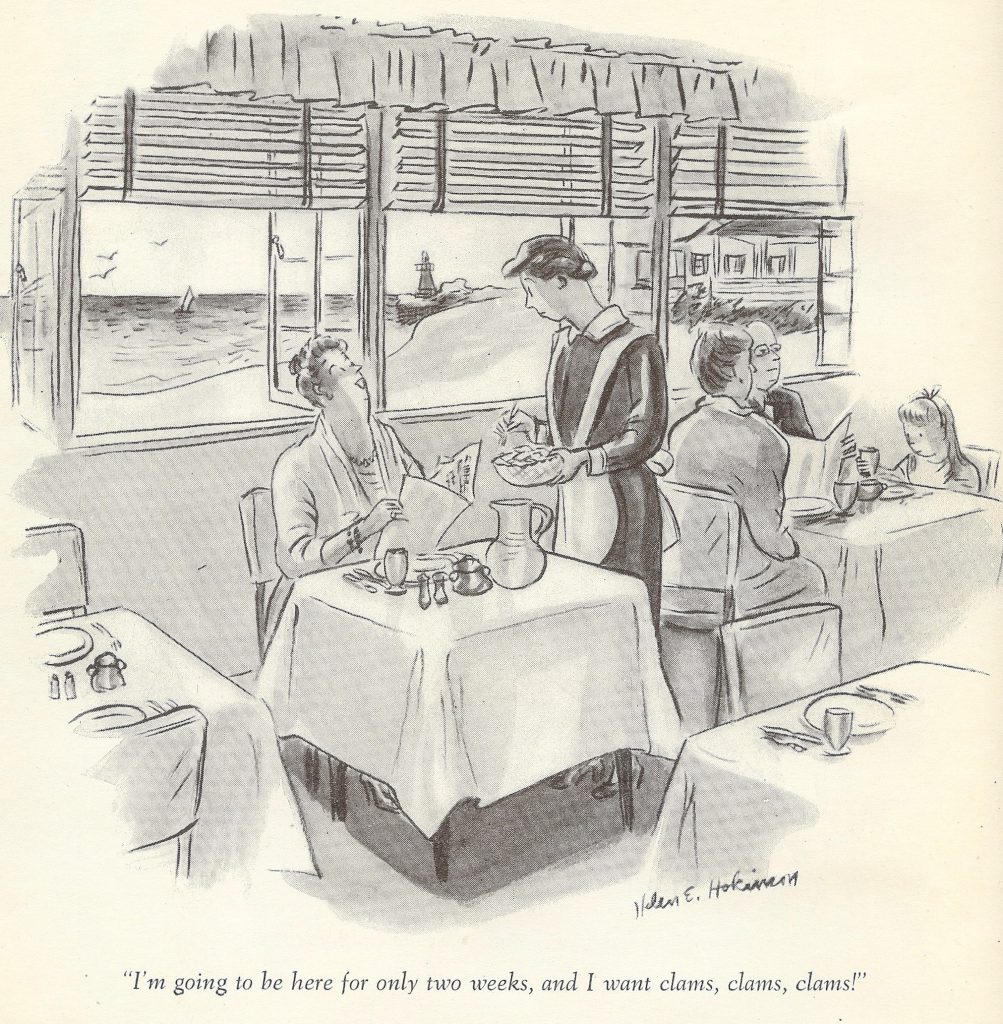Clams, clams, clams!


Facebook postings flash past one’s eyes. I didn’t catch the references, I didn’t capture the links. But one of them asked the question, Is Pacific Northwest clam chowder always made with thickeners of flour or cornstarch? Is it really supposed to have the consistency of caulking?
Some people seem to think that clam chowder is properly served only in a bread bowl, but out here on the Pacific coast, we most often use ceramic bowls, and always have. So it is really not necessary for our clam chowder to be thick and gluey. However, a quick check of recipes in popular regional cookbooks, such as A Taste of Oregon (Junior League of Eugene, 1980) and Portland’s Palette (Junior League of Portland, Oregon, 1992), does indicate that a substantial measure of flour is a common regional clam chowder ingredient in recent years.
Mo’s, a well-known Newport seafood restaurant (now with several outposts), stirs flour into their clam chowder, and it makes for a sludgy meal. On the other hand, Dooger’s, a Seaside restaurant (with two other outlets) that features clam chowder, shuns the flour.
A look backward reveals that a milkier, soupier version thickened only with potatoes was once the preferred Northwest chowder. In his autobiographical Delights and Prejudices (1964), James Beard gives a recipe from his childhood in the 1910s. The ingredients are bits of bacon, onion, potatoes (cooked until “soft and almost disintegrated”), clam broth, “light cream,” and clams, plus seasonings and a parsley garnish. This is very like what my parents prepared fifty years ago, although dad often omitted the bacon, to the dismay of the rest of the family. Beard also adds cognac, but we didn’t.
The recipe in Mary Cullen’s Cook Book (Binfords & Mort, 1938) is titled “Boston clam chowder,” and it includes salt pork or bacon, onions, potatoes, milk, water, celery, and clams; it directs one to “mash potatoes.” The same recipe is included in the successor volume, Mary Cullen’s Northwest Cook Book (1946), with an added note: “Razor clams are the favorite for this in the Northwest for they are plentiful along the Northwest beaches at low tide—if you know how to dig them.” Mary Cullen was the assumed name that the Portland Oregon Journal newspaper used for its home economics experts.
Mo’s, a well-known Newport seafood restaurant (now with several outposts), stirs flour into their clam chowder, and it makes for a sludgy meal. On the other hand, Dooger’s, a Seaside restaurant that features clam chowder, shuns the flour.
A look backward reveals that a milkier, soupier version thickened only with potatoes was once the preferred Northwest chowder. In his autobiographical Delights and Prejudices (1964), James Beard gives a recipe from his childhood in the 1910s. The ingredients are bits of bacon, onion, potatoes (cooked until “soft and almost disintegrated”), clam broth, “light cream,” and clams, plus seasonings and a parsley garnish. This is very like what my parents prepared fifty years ago, although dad often omitted the bacon, to the dismay of the rest of the family. Beard also adds cognac, but we didn’t.
The recipe in Mary Cullen’s Cook Book (Binfords & Mort, 1938) is titled “Boston clam chowder,” and it includes salt pork or bacon, onions, potatoes, milk, water, celery, and clams; it directs one to “mash potatoes.” The same recipe is included in the successor volume, Mary Cullen’s Northwest Cook Book (1946), with an added note: “Razor clams are the favorite for this in the Northwest for they are plentiful along the Northwest beaches at low tide—if you know how to dig them.” Mary Cullen was the assumed name that the Portland Oregon Journalnewspaper used for its home economics experts.
Stepping back a few decades, the Monday Club Cook Book published by Astoria’s First Presbyterian Church (1899) includes a clam soup recipe with only clams, milk, butter, salt, and pepper. However, as noted in an earlier blog post, my copy of the cookbook includes an additional recipe for clam chowder. The ingredients are clams, salt pork, potatoes, onions, milk, clam juice, salt and pepper—and when serving, “add five or six soda crackers.” No flour, no cornstarch.

Razor clam digging, ca. 1965
Beyond the issue of thick or thin consistency is the issue of the clams. There are a number of edible clams on the Oregon coast, but razor clams are a favorite and are the only clams I knew in my youth. I knew them because at various ungodly hours the whole family would rush to the shore at low tide with clam shovels and dig like fury for them. While this resulted in much general dampness (low tide seemed to occur most often during a driving winter rain) and sliced fingers impregnated with sea salt and sand, it also resulted in a couple of dozen clams. Sautéed clams and clam chowder were the usual results of these expeditions.
So I say, make your chowder of razor clams, and thicken that chowder with potatoes. Skip the cornstarch, omit the flour. Don’t forget the bacon (or salt pork). Celery if you like it.
It’s not the only clam chowder, just the best clam chowder.

East Coast clam fever: Helen E. Hokinson in the New Yorker, 1940s
2 Responses
Couldn't agree more. Growing up in Massachusetts, clam chowders were always relatively thin, thickened merely by milk and cream and the starch that came off the pre-cooked cubed potatoes.
Fish chowder was also quite common (again fairly thin), and I wonder why that has not caught on more in the PNW.
Nicholas
I agree, fish chowder seems not to have crossed the Rockies, and it does seem curious!
Comments are closed.